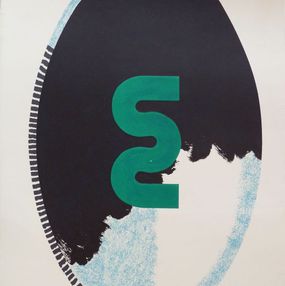


























Etude pour La Femme
Kumi Sugaï
Fine Art Drawings - 66 x 50 cm Fine Art Drawings - 26 x 19.7 inch
Sold


Art begins where technique ends.
Biography
Kumi Sugaï (Japanese, 1919–1996) was a painter and printmaker, who moved to Paris and adopted a western style in his art. Born in Kobe to Malaysian musicians, Sugai attended the Osaka School of Fine Arts, where he learned about European painting techniques in addition to classical Japanese painting and calligraphy.
In 1937, he dropped out to work as a designer at a railway company until the end of World War II. In 1952, Kumi Sugaï moved to Paris and absorbed western styles, including Abstract Expressionism, and later, Minimalism and Pop Art. At first, Sugai worked with traditional ukiyo-e woodblock techniques, using bright colors to create prints infused with contemporary western influences.
In the 1960s, however, Sugai transitioned into painting and printing more geometric images of letters and traffic and directional signs. He quickly met international success, and exhibited work at the Sao Paulo Biennale, documenta at Kassel, and the Venice Biennale, as well as solo shows in New York and Tokyo.
In addition to painting, Kumi Sugaï wrote essays on his artistic process and, inspired by his friend, Alberto Giacometti (Swiss, 1901–1966), translated the subject matter of some of his paintings into small sculptures. Though his work fell out of the public eye, Sugai continued to work in his geometric style for the rest of his life. Sugai died in his hometown of Kobe in 1996.
Read more
In 1937, he dropped out to work as a designer at a railway company until the end of World War II. In 1952, Kumi Sugaï moved to Paris and absorbed western styles, including Abstract Expressionism, and later, Minimalism and Pop Art. At first, Sugai worked with traditional ukiyo-e woodblock techniques, using bright colors to create prints infused with contemporary western influences.
In the 1960s, however, Sugai transitioned into painting and printing more geometric images of letters and traffic and directional signs. He quickly met international success, and exhibited work at the Sao Paulo Biennale, documenta at Kassel, and the Venice Biennale, as well as solo shows in New York and Tokyo.
In addition to painting, Kumi Sugaï wrote essays on his artistic process and, inspired by his friend, Alberto Giacometti (Swiss, 1901–1966), translated the subject matter of some of his paintings into small sculptures. Though his work fell out of the public eye, Sugai continued to work in his geometric style for the rest of his life. Sugai died in his hometown of Kobe in 1996.
Nationality
Categories
Artistic movements
Themes
Exhibitions dedicated to Kumi Sugaï
Discover our selections of works by artists
Need help finding your favorite? Consult our selection pages made for you.
Need to know more?
What are their 3 main works?
What is Kumi Sugaï’s artistic movement?
The artistic movements of the artists are: Colorful Geometric Painters, Suprematism
When was Kumi Sugaï born?
The year of birth of the artist is: 1919

